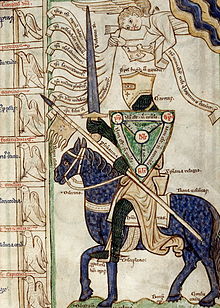Miles Christianus
This article needs additional citations for verification. (May 2013) |


The miles Christianus (Christian soldier) or miles Christi (soldier of Christ) is a Christian allegory based on New Testament military metaphors, especially the Armor of God metaphor of military equipment standing for Christian virtues in Ephesians 6:14–17 and on certain passages of the Old Testament (e.g. Job 7:1 (Vulgate): Militia est vita hominis super terram...).
The phrase miles Christi, derived from a letter from Paul the Apostle and much employed by Pope Gregory VII, also appeared in the Gesta Francorum in reference to the young Prince Tancred, Bohemond, Godfrey and Count Raymond of Toulouse,[1] each of whom were Christian leaders in the First Crusade.
The metaphor has its origins in early Christianity of the Roman Empire, and gave rise to the contrasting term paganus (hitherto used in the sense of "civilian", "one lacking discipline") for its opposite, i.e. one who was not a soldier of Christ.[2]
It became a theme in art during the High Middle Ages, with depictions of a knight with his various pieces of equipment identified with various virtues. This parallels the development of the understanding in medieval Christendom of the armed nobility as defenders of the faith, first emphasized by Gregory VII in the context of the Investiture controversy and later made even more explicit with the actual military expeditions of the crusades. Depictions of the miles christianus with the emblematic Armour of God however remained very rare in the medieval period and only became prominent after the Protestant Reformation.[3]
In the early modern period, the understanding of the term again became more metaphorical, but it survives in various Christian orders or confessions; it is especially pronounced among the Jesuits and in the Salvation Army, and it is the central theme of the 18th century hymn "Soldiers of Christ, Arise" and the 19th century hymn "Onward, Christian Soldiers."
See also
- Spiritual warfare (Christianity)
- Militia Dei
- Armor of God
- Shield of the Trinity
- Military order (society)
- Military saint
- Chivalry
- Crusades
- Mujahideen
References
- ^ Kostick, Conor (2008). The Social Structure of the First Crusade. Leiden, Netherlands: Koninklijnke Brill NV. p. 20.
- ^ Ernest Weekley, Etymological Dictionary of English, s.v. "pagan".
- ^ "depictions of the miles christianus in emblematic armour are extremely rare before the Reformation" (Evans p. 14)
- Michael Evans, "An Illustrated Fragment of Peraldus's Summa of Vice: Harleian MS 3244", Journal of the Warburg and Courtauld Institutes, vol. 45 (1982), pp. 14-68.
